Where playgrounds benefit adults, and a bridge between art and science opens minds
The benefits of greening Denver’s schoolyards have rippled outward
Landscape architect Lois Brink began thinking more about the impact of playgrounds after seeing the bleak yard at her children’s school. Between 2000 and 2012, she helped Denver Public Schools transform 99 schoolyards into vibrant, green spaces that prioritize physical activity, creative play, and outdoor learning.
A recent report commissioned by the Children & Nature Network found that these greener yards reduce average ambient temperatures in the summer, sequester carbon and remove pollutants from the air, and improve students’ academic performance and well-being. Given gains in high school graduation rates and community health, the analysis estimates the improvements could return $3 to a community for every $1 invested.
Why We Wrote This
Broad approaches to solve multiple challenges yield results in our progress roundup. In Denver, greener playgrounds satisfied children’s needs and made the air cleaner. In universities worldwide, new galleries spark creativity by showcasing disciplines that rarely share space.
Denver voters twice approved ballot measures to fund transformations that cost an average of $630,000 – which were also aided by pro bono services, volunteers, nonprofits, and the city.
Green schoolyards are “a multifaceted solution,” said Priya Cook of the Children & Nature Network. “Markets tend to underinvest in strategies that produce broad benefits to society. ...We have to think differently to pick multi-solving interventions.”
Sources: Grist, Children & Nature Network
Oslo’s Climate Budget is making it easier for the city to meet its climate goals
Created in 2016 after Norway signed the 2015 Paris Agreement, the Climate Budget puts a limit on citywide emissions, tracks progress, and recommends new interventions. As a fiscal tool, it is integrated into the budgeting process affecting all municipal departments.
The budget is helping the city transition to electric vehicles, create net-zero construction sites, expand cycling lanes by 100 kilometers (62 miles), and install carbon-capture technology. Since 2016, the city has reduced greenhouse gas emissions by 28% and is on track to reach 65% by 2030. Cycling has increased by 51%.
“Our politicians got tired of climate action plans that they ... sent out into the bureaucracy, but then it was never really followed up,” said Heidi Sørensen, director of the Oslo Climate Agency. “They needed a governance system.” The framework has inspired 200 other Norwegian municipalities to follow suit.
Source: World Resources Institute
Ethiopia has dramatically reduced the threat of tuberculosis
While largely controlled in some parts of the world, TB continues to be a leading cause of death across Africa. Ethiopia had the world’s highest mortality rate from TB in 1980, with 394 deaths per 100,000 individuals. Following decades of public health initiatives, the East African country has reduced that rate sixfold, outpacing the progress made by countries facing the same problem.
In high-income nations, fewer than 1 in 100,000 people die from the disease each year. Still, life expectancy overall has increased across eastern sub-Saharan Africa, more than in any other region in recent decades, largely due to efforts in addressing TB and other prominent diseases.
Sources: Our World In Data, Institute for Health Metrics and Evaluation
Lavender oil can be used to make mosquito-repellent fabric
Traditional synthetic repellents protect against mosquitoes and the diseases they carry but can cause their own health issues. Lavender oil is a natural alternative, but its compounds break down quickly in normal conditions. Textile engineers Zeeshan Tariq and Xiaoqin Wang at Soochow University in China discovered a way to prolong the effect.
Their team mixed lavender oil into a warm solution of fibroin, a flexible protein made by silkworms, and gum arabic, a substance from acacia trees that helps stabilize materials. When stirred, the mixture forms tiny lavender oil capsules that can be embedded in cotton fabric. Tests showed that gloves made from this fabric significantly reduced mosquito landings compared with regular gloves. Even after 40 washes, the treated fabric remained effective.
Source: The Economist
A new type of gallery is bridging the gap between art and science
In some educational systems, the arts and sciences are treated as entirely separate disciplines with little room for overlap. The Science Gallery aims to “[ignite] creativity and discovery where science and art collide” at its locations in Ireland, the United States, Australia, Britain, Germany, Mexico, and now India.
The latest addition in Bengaluru, also known as the Silicon Valley of India, features an exhibition, “Carbon,” that illustrates the human body by displaying varying sizes of jars filled with charcoal powder corresponding to the amount of carbon in each body part. The museum also hosts workshops, lectures, and performances and is planning an exhibition on the workings of quantum physics for next year.
Commentators have noted the importance of this sort of space in a place like India, where, despite a growing number of universities, multidisciplinary institutes are uncommon, and scientific output lags behind those of other large economies.
Sources: The Economist, Science Gallery









